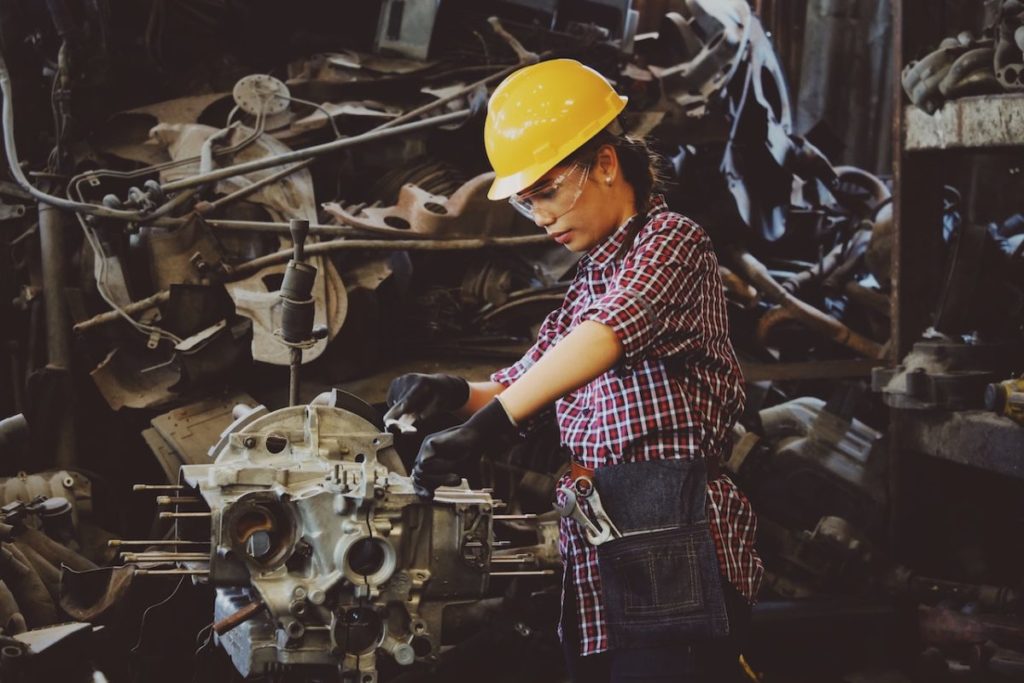
Mechanic Audra Fordin says the majority of customers who drive up to her shop, Great Bear Auto Repair, are women. Her applicant pool is another story.
“Women are a huge market, yet women are not in our [trade’s] labor force,” she says. And she gets why. “I go into another auto shop, and there are no women there. So there are no role models to follow – no women in the field.”
The reason for that is no mystery, either. When Fordin reaches out to local trade schools in search of workers, she hears stories of girls being discouraged by guidance counselors – who often urge them toward cosmetology, Fordin reports – and parents alike.
Trade jobs, generally speaking, are defined by the training they require from specialized schools and apprenticeship programs – think auto repair, construction and plumbing. The average trade worker in the U.S. makes about $47,500 per year, which falls shy of America’s national average of $58,000 per year – though depending on the trade, salaries could get up as high as $98,000, per the Bureau of Labor Statistics.
But there’s one big difference, regardless: no costly 4-year degree, or related loans, required for a career path. In fact, apprentices tend to earn as they learn. And unlike some other industries, there are plenty of job openings to go around.
Yet there’s a dearth of tradeswomen to fill those roles – that’s not just Fordin’s anecdotal observation. According to the U.S Department of Labor, only 11% of those people who completed apprenticeships in 2020 were women. Representation for women in trade jobs is similarly dismal – a 2021 study from the Institute for Women’s Policy Research found that women make up just shy of 4% of that workforce.
Worse still, women who do find work in these fields face gendered discrimination on several fronts. The result, says Meg Vasey, executive director of Oakland, California-based advocacy organization Tradeswomen Inc., is “a very complicated environment” where women workers are left feeling “so isolated.”
Built-In Problems
Vasey has been involved in trade work since 1978 – first as an electrician and construction worker assigned to high-rise buildings and oil refineries, then as an advocate for fellow tradeswomen after she earned her law degree from the University of California, Berkeley’s School of Law.
Decades of advocacy work, not to mention lived experience, have shown Vesey that “you are faced with a lot of obstacles the minute you start” as a tradeswoman, from apprenticeship on up, in large part “because you’re an oddity.”
Jessica Stender, policy director of workplace equity organization Equal Rights Advocates who works often with Tradeswomen, Inc., adds that recruitment is just one half of the issue – retention is a big problem too. Some of that comes from nepotism, Vasey says – the perpetuation of a boys’ club ethos that sees male relatives of male workers frequently offered jobs ahead of women. (It’s so common that the phenomenon even has its own acronym, she notes: “FBI,” short for “friends, brothers and in-laws.”)
But even worse is “discrimination and harassment in programs and jobs” severe enough to “either push [women] out or at least hold them back,” Stender says, which runs the gamut from sexist comments about tradewomen’s competencies to outright sexual harassment.
Researchers at the IWPR found this, too. Their work shows that roughly 48% of tradeswomen grapple with gendered discrimination and hostile attitudes from male colleagues on a regular basis. More than a quarter reported frequent on-the-job sexual harassment. Nearly 45% say they’ve considered leaving their careers behind altogether to escape such treatment.
“Every woman I know [in the trades] has some form of PTSD … in light of discrimination and harassment. I don’t want to sound like a flower, but it is very difficult,” Vasey says, recalling incidents like needless yelling and openly displayed pornography.
The dearth of social safety nets that plagues women overall affects tradeswomen, too – a lack of affordable, reliable childcare and caregiver options, for example. And for women of color, there’s another layer of hardship, still. Jennifer Todd, founder of Georgia’s LMS General Contractors, has been in the trade world for just over 15 years. And though she’s in a leadership position, even she can’t shake the pay gap that also plagues employee tradeswomen.
Todd, a Black woman, reports hearing that she’s been offered less pay for jobs than her competitors, because “unfortunately, in some cases, people see me as a Black person or a woman before they see the work that I‘m capable of doing.”
Paving the Road Themselves
The lack of support for women and minorities in the trades is hurting not only workers, but the industry itself. Trade organizations report significant gaps between the amount of roles on offer and the amount of people available to fill them.
Todd isn’t surprised. As a result of “being white-male-dominated industry for so long, now, we’ve crippled ourselves,” she says. “There’s billions [of dollars] in infrastructure work to do, and we don’t have the people to support it, because we haven’t showcased a willingness to hire minorities and women, and retain them.”
Federal contracting programs have been one significant focus for advocates when it comes to turning the tide. And it should be a “gimme,” as Executive Order 11246, issued by President Lyndon Johnson in 1965, prohibits discrimination in hiring for federal contract work. But the government has been lax on enforcement, and “women have suffered” as such.
“They set an expectation of 6.9% women on federal contracting jobs – I’m still waiting,” Vasey adds.
In addition to petitioning lawmakers, tradeswomen are also finding ways to address leaks within their industry’s pipeline themselves. Both Todd and mechanic Fordin have started their own programs to help marginalized people better understand trade work – Greener Tomorrow and Women Auto Know, respectively – in bids to diversify the talent pool.
Stender at Equal Rights Advocates adds, “We do outreach to girls and women to make them aware of [trade work] opportunities, because they are so often geared toward men.”
There are signs that some, at least, are beginning to understand the need to seek out non-male, non-white tradeworkers. Data points to a recent surge in women construction workers – Latinx women in particular – as managers seek to fill those still-empty positions. Much of the growth is happening on work sites, not back-office jobs, The Washington Post recently reported.
And Vasey, who recently attended this year’s Tradeswomen Build Nations, a national conference organized by North America’s Building Trades Unions, recalls the thrill of seeing thousands of women construction workers, electricians, plumbers and more gathered for the event – a sight she says would have been “unimaginable” at the start of her career.
Which left her with one big takeaway on the trade world’s pipeline problem: “It can be fixed.” ◼️




